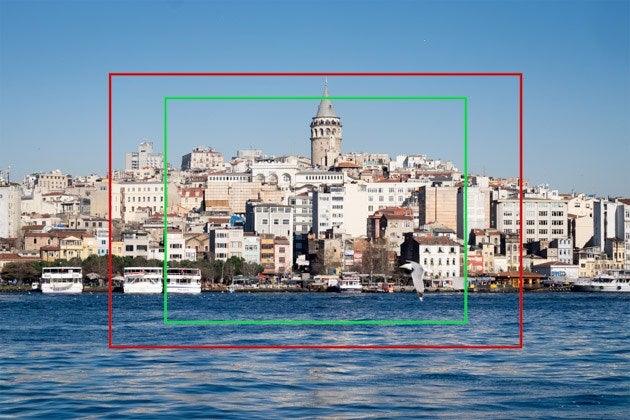Ildan :
You are not wasting you time! Thank you for it

it's always better to have advices from real people.
Be sure It will be useful for many people wondering the same as I am.
Consider just buying any camera body that interests you. Then a quality kit lens. And neither a macro nor wide angle. Instead try for a kit lens which is modestly wide and has at least a little close focus ability.
An image for you to consider:
The whole image is what a full frame camera would capture with a given focal length. The red box is an aps-c. The innermost green box is a m4/3 camera.
Another thing you can derive from the above photo. What would the above scene look like at the equivalent of 24, 35 or 50mm. For APS-C this would take a 13, 20 or 25mm lens. With an APS-C it would take a 10, 15 or 25mm. Or put another way, a 60mm lens on a m4/3 (120mm equiv) would have very buildings in it.
There is a thing called focal length equivalence or crop factor. The full frame has a crop factor of 1 (it is the base). So a 20mm lens looks like a 20mm lens. APS-C has a crop factor of 1.5 (unless it is Canon, as they use slightly smaller sensors). So on a Nikon APS-C body, a 20mm lens looks like a 30mm one (20 x 1.5). Finally on a m4/3 a 20mm lens looks like a 40mm lens.
A landscape lens generally runs in the 15-35 range. Or aps-c 10-24 and m4/3 7-18mm
So a lens like I mentioned above for an APS-C DSLR, this would mean a lens which starts at 16mm. For a m4/3 this would mean a lens which starts 12mm. In the case of m4/3, for the same light gathering you will need at least a full-stop faster lens. The smaller lens lets in less light of course.
When you look at your images you're going to find that actual landscape images with any "pop" are going to be at the extreme wide end of these lenses.
Here is a focal length simulator to give you some idea.
http

/imaging.nikon.com/lineup/lens/simulator/
If you want landscapes to look good, you zoom with your feet and keep the lens wide.
These are expensive, and not recommendations, but just a comparative so you can go find what you want.
Of comparible quality would be a Nikon d7500 and a 16-80mm f/2.8-4 and a Olympus O-MD E-M1 mk2 with a 12-40mm f/2.8. The Nikon would have the edge in image quality by a little bit (better dynamic range, better over all light gathering, better ISO noise) There is a older "starting lens for Nikon, the 16-85 which would make the Nikon and Oly the nearly same image quality. This nikon lens can be had for much less money, especially if you get it used. The lens which matches this one optically is the Panasonic 12-60 f/2.8-4, but that lens is very expensive. So the downgrade lens for m4/3 12-60mm panasonic f/3.5-5.6 (or Olympus 12-50mm f/3.5-5.6). Of the m4/3 downgrades the Panasonic is better but the Oly has better close focus.




 /www.dpreview.com/forums/thread/3669391
/www.dpreview.com/forums/thread/3669391